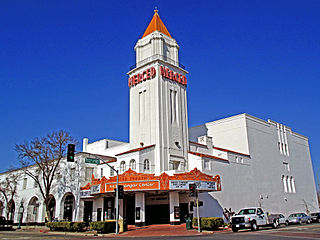
The Murdock School, also known as Old Murdock High School, is an historic school building on Murdock Avenue in Winchendon, Massachusetts. Built in 1887 to a design by Henry M. Francis, it is the town's most architecturally elaborate school building. It served as the town's high school until 1961, and now houses the local council on the aging. The building was listed on the National Register of Historic Places in 1988.

The Reading Public Library is located at 64 Middlesex Avenue in Reading, Massachusetts. Previously known as the Highland School, the two-story brick-and-concrete Renaissance Revival building was designed by architect Horace G. Wadlin and built in 1896–97. The building served the town's public school needs until 1981. It is the town's most architecturally distinguished school building. It was listed on the National Register of Historic Places in 1984, the year it was converted for use as the library.

English High School is an historic high school building at 20 Irving Street in Worcester, Massachusetts. Built in 1891, it is a prominent local example of Romanesque Revival architecture, designed by the local form of Barker & Nourse. It served the city as a high school until 1966, and has housed school administration offices since then. The building was listed on the National Register of Historic Places in 1980.

The Goffstown Public Library is located at 2 High Street in Goffstown, New Hampshire. The building it occupies was designed by architects Henry M. Francis & Sons and was built in 1909. It is small Classical Revival building built of brick with stone trim, and was added to the National Register of Historic Places in 1995. It is one of the finest examples of Classical Revival architecture in the town, with a three-bay main facade whose central entrance projects slightly, and is topped by a pediment supported by Ionic columns.

The Dr. Daniel Lathrop School is a historic school building at 69 East Town Street in the Norwichtown section of Norwich, Connecticut. It is a single-story brick structure with a gambrel roof, located facing the village green next to the Joseph Carpenter Silversmith Shop, another historic building. Built in 1782, it is one of the oldest surviving brick school buildings in the state. The building was listed on the National Register of Historic Places on December 29, 1970. It now serves as a visitors center for the local historical society.
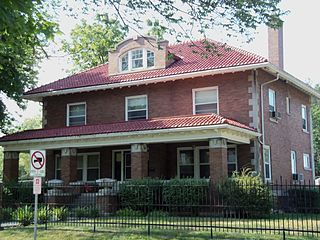
The Arthur Ebeling House is a historic building located on the west side of Davenport, Iowa, United States. The Colonial Revival house was designed by its original owner, Arthur Ebeling. It was built from 1912-1913 and it was listed on the National Register of Historic Places in 1984.

The Webster Rock School is an historic school building located NC 116 / Main St., at Webster, Jackson County, North Carolina. It was built between 1936 and 1938 by the Works Progress Administration, and is one story with hip roof utilitarian building, constructed of native "river rock" in colors of tan and brown. It has an "E"-shape plan and has a 13 bay front facade. The school originally contained an auditorium, cafeteria, kitchen and eight classrooms.

Roger Williams Public School No. 10, also known as South Scranton Catholic High School, is a historic school building located at Scranton, Lackawanna County, Pennsylvania.
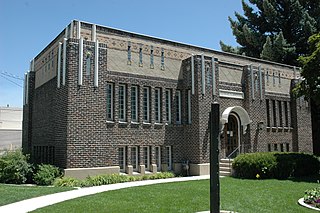
The Springville Carnegie Library at 175 South Main Street in Springville, Utah, United States is a Prairie School style Carnegie library building completed in 1922. It is one of the 23 Carnegie Libraries that were built in Utah. It functioned as the city public library until 1965, when the library was moved to a new larger building. The 1922 building was listed on the National Register of Historic Places in 1991. It now houses a pioneer relic museum for the Daughters of the Utah Pioneers.

Public School No. 29, also known as Lamborn Library, is a historic school building located at Hockessin, New Castle County, Delaware. It was built in 1870 as a one-room school; a second floor and classroom was added about 1890. is a two-story, brick building on a stone foundation with basement. It has a gable roof and features fish-scale shingles and Stick style detailing on the gable ends. It was occupied by a school until 1932, after which it was used as a library and community center. The library moved to a new building in 1994.
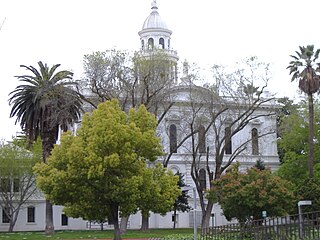
The Merced County Courthouse is the historic county courthouse in Merced County, California. Located at the intersection of W. 21st and N Streets in Merced, the building served as Merced County's courthouse from 1875 until 1975. A. A. Bennett, an architect who also worked on the California State Capitol, designed the building. The building's Italian Renaissance design was styled to resemble a palazzo; it features a white plaster exterior, a portico with a balcony on the south side, and a cupola atop the roof. A nearly identical courthouse was built in Fresno County at the same time; this building was modified extensively and later demolished, leaving the Merced County Courthouse as the only remaining example of its design. The building's architecture is unique within the southern Central Valley; in its National Register nomination, the courthouse was called "the best example of the Italian Renaissance revival remaining between Sacramento and Los Angeles".

North River High School was a historic public school building located at Moscow, Augusta County, Virginia. Built in 1930, it was a brick building consisting of an auditorium/gymnasium as the core of the building with rectangular gabled blocks on either side containing two rooms with the projecting gable ends. It had a steeply pitched gable roof and entrance portico reflecting the Colonial Revival style. Additions were made to the building in 1942 and 1950. Also on the property was a contributing brick agriculture building.

The Dallas County Training School High School Building is a historic school building at 934 Center Street in Fordyce, Arkansas. Built in 1934 with funding from the Rosenwald Fund, it was the only high school serving African Americans in a four-county region of southern Arkansas until 1940. Its original block is a rectangular brick structure with a gable-on-hip roof; a flat-roof addition was made to the rear in 1954. The building house grades 6-12 of African Americans until 1970, when the city's schools were integrated. At that time it became an elementary school, and was finally closed in 2001.
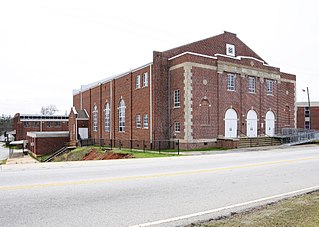
Parker High School Auditorium is a historic high school auditorium located at Greenville, South Carolina. It was built in 1938 with funding provided by the Works Progress Administration. It is a Classical Revival style 7500 square foot rectangular brick building with a front gabled roof. It is the last remaining building from the largest WPA school project in South Carolina.
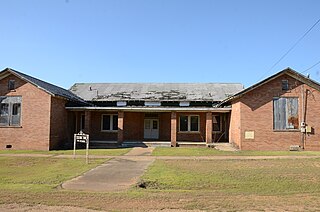
The Lafayette County Training School is a historic school building at 1046 Berry Street, on the former campus of Ellis High School in Stamps, Arkansas. It is a single-story brick building with gable roof, built in 1929 with assistance from the Rosenwald Fund. It is laid out in the shape of an H, and houses six classrooms in the side wings, with an office, library, and auditorium in the center. It is the only surviving Rosenwald School in Lafayette County. It served the area's African-American student population until 1969, when the county schools were integrated. It thereafter served as an integrated middle school until 1975, and for a time as a daycare center afterward.

William Penn High School, also known as High Point Normal & Industrial Institute, is a historic high school for African-American students located at High Point, Guilford County, North Carolina. The high school building was built in 1910-1911, and enlarged and renovated in 1929-1930. It is a two-story, 12 classroom Colonial Revival style brick building. It has a projecting three-bay entrance pavilion. Two other buildings associated with the High Point Normal & Industrial Institute are on the property. The Institute was established by Quakers in 1891. They were built about 1910 and are a gable end frame structure sheathed in corrugated metal with a distinctive monitor roof and a brick building with a low pitched roof. The school closed in 1968.

Harnett County Training School, also known as Harnett High School, is a historic school complex for African-American students located at Dunn, Harnett County, North Carolina. The complex was built between 1922 and 1956, and consists of one two-story and five single-story brick buildings. They include a gable front combined Gymnasium/Auditorium (1948); the two-story, 14 teacher, flat-roofed, Colonial Revival-style Rosenwald-funded Harnett County Training School (1922); a detached brick boiler room (1950); two, one-story, flat-roofed Library and Office Building and Cafeteria buildings (1956); and a one-story, flat-roofed Rosenwald-funded classroom annex added in 1927, now designated the Education Building.

Marshall High School is a historic high school building located at Marshall, Madison County, North Carolina. It was designed by noted Raleigh architect Frank B. Simpson and built in 1926. It is two-story-plus-basement, "U"-shaped brick building with a low hip roof in the Colonial Revival style. Marshall High School continued to serve the community until a new high school was built in 1973. The building was damaged in a flood in 2004, and was subsequently renovated starting in February 2007.

Old Southport High School, also known as the Old Southport Middle School, is a historic high school building located at Indianapolis, Marion County, Indiana. It was built in 1930, and is a two-story, "U"-shaped, Colonial Revival style steel frame and concrete building sheathed in red brick with limestone detailing. It has a side gabled roof topped by an octagonal cupola. The front facade features a grand portico supported by six Corinthian order columns.

The Ashwood School is a historic school building at 5604 United States Route 220 in Hot Springs, Virginia. It is a two-story brick building with a low-pitch hip roof and modest Classical Revival styling. It was built about 1909, and served all grades until 1927, when a new high school was built. It then served as an elementary school until its closure in 1969. It served only white students in the racially segregated county school system until 1965, when court cases mandated its integration.

